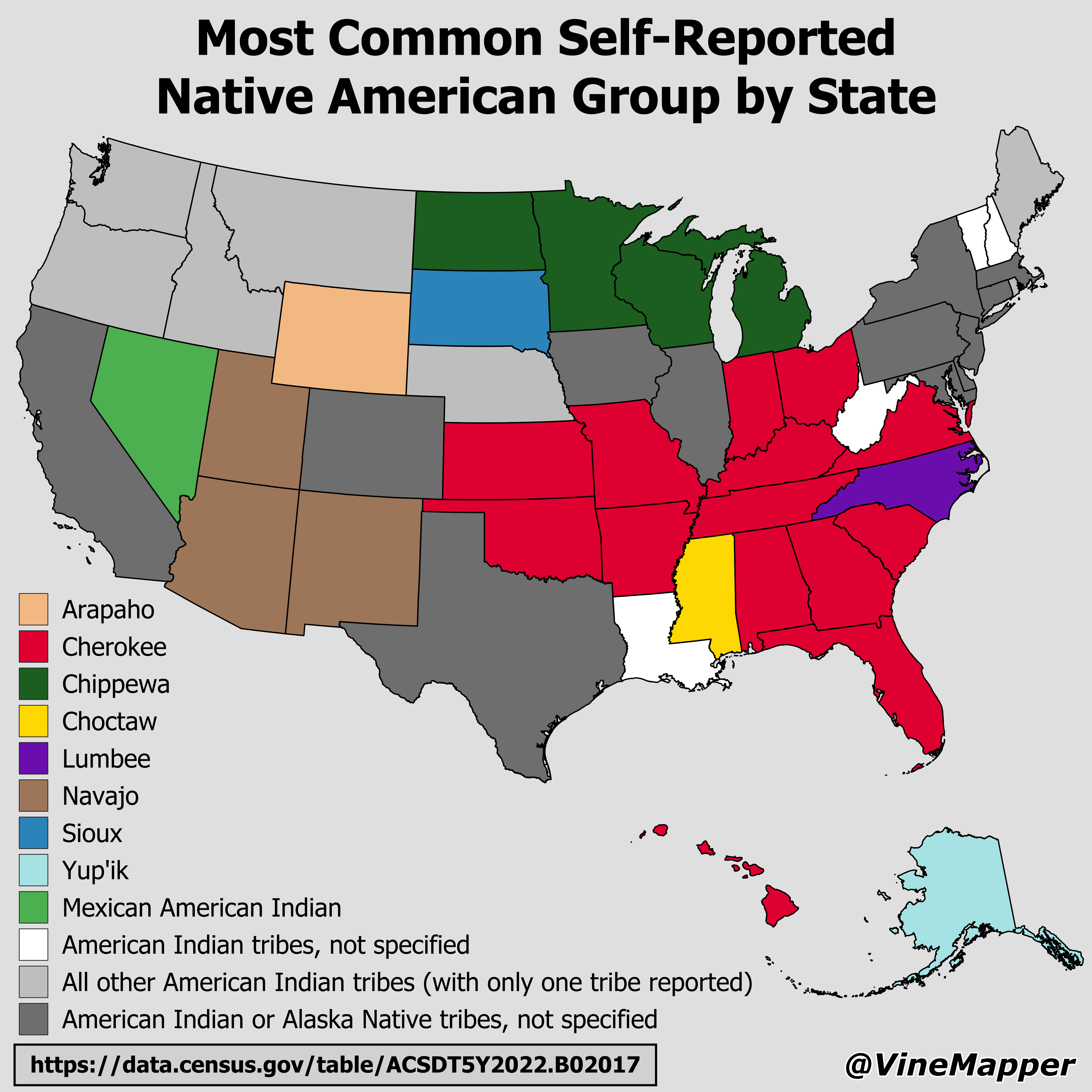Most Common Self-Reported Native American Group by State Map


Alex Cartwright
Senior Cartographer & GIS Specialist
Alex Cartwright is a renowned cartographer and geographic information systems specialist with over 15 years of experience in spatial analysis and data...
Geographic Analysis
What This Map Shows
The "Most Common Self-Reported Native American Group by State" map provides a detailed visualization of the predominant Native American tribes identified by individuals across the United States. This map highlights the diversity and distribution of Native American groups, offering insights into the cultural and historical significance of these populations in their respective regions. Immediately, it draws our attention to the rich tapestry of Native identities that have been established long before the arrival of Europeans and continue to thrive today.
Deep Dive into Native American Groups
Native American tribes have a profound historical and cultural significance in the U.S. Today, over 570 federally recognized tribes exist, each with its unique language, traditions, and governance structures. The diversity among these tribes is staggering; for instance, the Navajo Nation, primarily located in Arizona, New Mexico, and Utah, is the largest tribe in terms of population and land area. In contrast, tribes like the Lumbee in North Carolina, while not federally recognized, represent significant cultural identities in their regions.
Interestingly, the self-reported nature of this map reveals not only the presence of these tribes but also the connection individuals feel to their heritage. The reasons for self-identifying with a particular Native American group can range from familial heritage to community involvement. It’s essential to acknowledge that many Native Americans belong to multiple tribes or possess mixed heritage, making the categorization complex yet fascinating.
Demographically, Native Americans represent about 2% of the total U.S. population, with significant concentrations in specific states. For example, Alaska boasts a high percentage of Native American individuals, primarily comprised of the Inuit and Aleut peoples, while states like South Dakota and Montana have a strong representation of tribes such as the Lakota and Crow. These population distributions are often influenced by historical migration patterns, treaties, and the establishment of reservations, which have shaped where Native communities are located today.
In addition to understanding the demographics, the map prompts us to consider the current challenges faced by Native American groups. Issues such as land rights, cultural preservation, and access to education and healthcare remain central to the conversations surrounding Native American identity and self-determination.
Regional Analysis
Examining the map reveals distinct regional patterns in the self-reported Native American groups. For instance, the Southwestern states, including Arizona and New Mexico, are home to numerous tribes, including the Navajo, Apache, and Zuni. Each of these tribes has a rich historical background and continues to influence the cultural landscape of the region through art, language, and traditional practices.
In contrast, the Northern Plains states, like South Dakota and North Dakota, are predominantly associated with tribes such as the Sioux and Assiniboine. The historical significance of these tribes is highlighted by events like the Battle of Little Bighorn and the Wounded Knee Massacre, which continue to resonate in the collective memory of Native Americans and their allies.
Interestingly, the Pacific Northwest showcases a different dynamic, with tribes like the Nez Perce and the Coast Salish peoples, who have adapted their traditions to modern influences while still maintaining their cultural heritage. The tribal recognition status varies significantly across the U.S., affecting funding, governance, and cultural preservation efforts. For example, tribes that are federally recognized often have access to resources that aid in education, healthcare, and infrastructure development, while those that are state-recognized or unrecognized face significant challenges in these areas.
Significance and Impact
Understanding the distribution of Native American groups is crucial for several reasons. Firstly, it highlights the ongoing legacy of colonization and the importance of recognizing and respecting Native sovereignty. As we move forward, acknowledging the rights and histories of Native peoples becomes increasingly vital in addressing social justice issues.
Moreover, this map serves as a reminder of the cultural richness that Native American tribes contribute to the national identity. From traditional ceremonies to contemporary art forms, Native American cultures continue to evolve, influencing American society in profound ways. As conversations around cultural appreciation versus appropriation grow, understanding the complexities of Native identity and representation becomes essential.
Looking ahead, current trends indicate a growing interest in indigenous rights and cultural revival among younger generations, both within and outside Native communities. This resurgence offers hope for the future as more individuals seek to reconnect with their heritage, fostering a greater appreciation for the contributions of Native American tribes to the broader American narrative. By engaging with this map, we can better understand the significance of Native American groups in shaping the cultural and historical landscapes of their regions and the nation as a whole.
Visualization Details
- Published
- September 27, 2025
- Views
- 54
Comments
Loading comments...